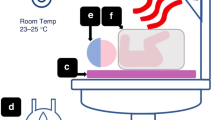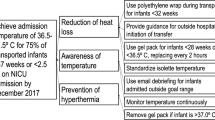Abstract
Objective:
To compare the admission temperatures, incidence of hypothermia and discharge outcomes of preterm neonates managed with Trans-warmer mattress (TWM) initiated in the delivery room (DR) and controls.
Study Design:
A prospective quasi-randomized controlled trial was performed between January and November 2009 on preterm neonates <32 weeks gestation. Infants in the intervention group were resuscitated and transported to neonatal intensive care unit (NICU) on a TWM, in addition to other measures recommended by the Neonatal Resuscitation Program.
Result:
The mean (s.d.) gestational age 28.7 (3) vs 28.7 (2.4) weeks and birth weight 1151 (407) vs 1175 (413) g) were comparable in the intervention (n=53) and control (n=49) groups. Temperature of the DR, maternal temperature, 5 min Apgar score, mode of delivery, cord pH and need for resuscitation were similar in both groups. Temperature of neonates in the DR (36.3 vs 36.0 °C) was also similar. Admission temperature in the NICU was significantly higher 36.2 °C (0.8) vs 35.7 °C (0.8) and incidence of hypothermia (temperatures <36 °C) lower in the intervention group (34 vs 57%, P<0.05). TWM use was not associated with any adverse effects. On logistic regression, low birth weight, lack of use of TWM and low DR temperature were independently associated with admission hypothermia.
Conclusion:
In this quasi-randomized controlled trial, the admission temperatures of preterm neonates on whom TWM was used were significantly higher compared to controls with a reduction in the incidence of hypothermia. A TWM initiated in the DR may be a simple efficacious method of reducing hypothermia in preterm neonates.
This is a preview of subscription content, access via your institution
Access options
Subscribe to this journal
Receive 12 print issues and online access
$259.00 per year
only $21.58 per issue
Buy this article
- Purchase on Springer Link
- Instant access to full article PDF
Prices may be subject to local taxes which are calculated during checkout

Similar content being viewed by others
References
Dahm LS, James LS . Newborn temperature and calculated heat loss in the delivery room. Pediatrics 1972; 49 (4): 504–513.
Yashiro K, Adams FH, Emmanouilides GC, Mickey MR . Preliminary studies on the thermal environment of low-birth-weight infants. J Pediatr 1973; 82 (6): 991–994.
WHO Organization. Safe Motherhood: Thermal Protection of the Newborn: A Practical Guide. WHO Organization: Geneva, 1997.
Laptook AR, Salhab W, Bhaskar B . Admission temperature of low birth weight infants: predictors and associated morbidities. Pediatrics 2007; 119 (3): e643–e649.
Costeloe K, Hennessy E, Gibson AT, Marlow N, Wilkinson AR . The EPICure study: outcomes to discharge from hospital for infants born at the threshold of viability. Pediatrics 2000; 106 (4): 659–671.
Ibrahim CP, Yoxall CW . Use of plastic bags to prevent hypothermia at birth in preterm infants—do they work at lower gestations? Acta Paediatr 2009; 98 (2): 256–260.
Harms K, Herting E, Kron M, Schill M, Schiffmann H . Importance of pre- and perinatal risk factors in respiratory distress syndrome of premature infants. A logical regression analysis of 1100 cases. Z Geburtshilfe Neonatol 1997; 201 (6): 258–262.
Elliott RI, Mann TP . Neonatal cold injury due to accidental exposure to cold. Lancet 1957; 272 (6962): 229–234.
Gandy GM, Adamsons Jr K, Cunningham N, Silverman WA, James LS . Thermal environment and acid–base homeostasis in human infants during the first few hours of life. J Clin Invest 1964; 43: 751–758.
Chadd MA, Gray OP . Hypothermia and coagulation defects in the newborn. Arch Dis Chld 1972; 47 (255): 819–821.
Stephenson JM, Du JN, Oliver Jr TK . The effect of cooling on blood gas tensions in newborn infants. J Pediatr 1970; 76 (6): 848–852.
Pediatrics AA . Textbook of Neonatal Resuscitation, 5th edn. American Heart Association: Elk Grove Village, IL, 2006.
Singh A, Duckett J, Newton T, Watkinson M . Improving neonatal unit admission temperatures in preterm babies: exothermic mattresses, polythene bags or a traditional approach? J Perinatol 2010; 30 (1): 45–49.
Bell MJ, Ternberg JL, Feigin RD, Keating JP, Marshall R, Barton L et al. Neonatal necrotizing enterocolitis. Therapeutic decisions based upon clinical staging. Ann Surg 1978; 187 (1): 1–7.
Papile LA, Burstein J, Burstein R, Koffler H . Incidence and evolution of subependymal and intraventricular hemorrhage: a study of infants with birth weights less than 1500 g. J Pediatr 1978; 92 (4): 529–534.
Brennan AB . Effect of sodium acetate mattress on admission temperatures of infants <1500 g (Master's thesis). University of Florida: Gainesville, FL, 1996.
Singh A, Duckett J, Newton T, Watkinson M . Improving neonatal unit admission temperatures in preterm babies: exothermic mattresses, polythene bags or a traditional approach? J Perinatol 2009; 30 (1): 45–49.
Almeida PG, Chandley J, Davis J, Harrigan RC . Use of the heated gel mattress and its impact on admission temperature of very low birth-weight infants. Adv Neonat Care 2009; 9 (1): 34–39.
Gunn AJ, Bennet L . Is temperature important in delivery room resuscitation? Semin Neonatol 2001; 6 (3): 241–249.
Acknowledgements
The study was supported by ‘Ashok and Ingrid Sarnaik Endowment for Residents and Fellows Research’ at Children's Hospital of Michigan, Detroit, MI. The funders had no involvement in study design, data collection, analysis/interpretation of data, in writing of the paper or in the decision to submit the paper for publication.
Author information
Authors and Affiliations
Corresponding author
Ethics declarations
Competing interests
The authors declare no conflict of interest.
Rights and permissions
About this article
Cite this article
Chawla, S., Amaram, A., Gopal, S. et al. Safety and efficacy of Trans-warmer mattress for preterm neonates: results of a randomized controlled trial. J Perinatol 31, 780–784 (2011). https://doi.org/10.1038/jp.2011.33
Received:
Revised:
Accepted:
Published:
Issue Date:
DOI: https://doi.org/10.1038/jp.2011.33
Keywords
This article is cited by
-
Thermoregulation for very preterm infants in the delivery room: a narrative review
Pediatric Research (2024)
-
Delivery room care and neonatal resuscitation while on intact placental circulation: an open-label, single-arm study
Journal of Perinatology (2021)
-
Standard care with plastic bag or portable thermal nest to prevent hypothermia at birth: a three-armed randomized controlled trial
Journal of Perinatology (2018)
-
Implementation of a multidisciplinary guideline improves preterm infant admission temperatures
Journal of Perinatology (2017)
-
Die Versorgung und Reanimation des Neugeborenen
Notfall + Rettungsmedizin (2015)



